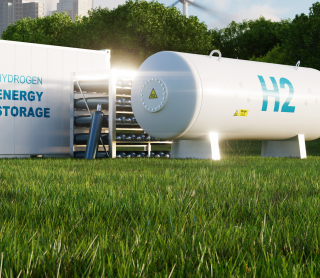CGO Scott Slessman Shares Hydrogen Insights with Climate Change Business Journal
The Climate Change Business Journal recently tapped SWCA’s Chief Growth Officer Scott Slessman for its Q2 2024 Hydrogen & the Smart Transition edition. This issue looks at how the promise of hydrogen has the clean energy world diving into hydrogen applications across all major energy categories.
Slessman shared insights into the current state of the renewable energy industry and the role hydrogen plays within the energy transition. He also provides SWCA’s perspective on the infrastructure needed to effectively generate and use hydrogen, the challenges of permitting and planning hydrogen developments, society’s concerns regarding hydrogen, and how technology is helping advance hydrogen projects across the value chain.
Read the Q&A below to learn more about the services SWCA provides related to hydrogen, including sustainability and management consulting to assess the risks and opportunities and develop the business case for proposed sustainability initiatives (including hydrogen developments) and environmental consulting to support the siting, permitting, and environmental planning for hydrogen projects and its associated infrastructure.
The below text is an excerpt from the Climate Change Business Journal Q2 2024: Hydrogen & the Smart Transition.
Download the full Q&A with SWCA CGO Scott Slessman here.
SWCA Assesses Risks and Opportunities to Develop a Business Case for Sustainability & Hydrogen
CCBJ: How would you describe the current state of the renewable energy industry?
Scott Slessman: Decreasing costs, favorable regulatory frameworks, new technology, and a greater recognition of the need for sustainable energy solutions and decarbonization efforts have propelled the renewable energy industry’s sustained growth and evolution. The renewable energy sector (wind, solar, hydroelectric, and various other sources) continues to expand. For example, solar energy has been growing at a rate of 22% year-over-year, according to SEIA. This growth can be attributed to more efficient technology that led to lower development costs, advantageous financial policies, and the increasing urgency to address climate change.
Over the past decade, the costs of renewable energy technologies, especially solar and wind power, have dropped dramatically. Now, renewable energy is often as affordable, or even more cost-effective, than fossil fuels in many places. This financial benefit has accelerated adoption, contributing to the broader integration of renewable energy solutions into global energy portfolios. Many governments are also establishing policies and offering incentives with the goal of encouraging renewable energy developments. Incentives cover a variety of measures such as feed-in tariffs, renewable portfolio standards, tax breaks, and subsidies. As new applications for use of renewables increase, for example in the clean hydrogen industry, policies will continue to expand the development of renewable energy projects.
Ongoing research and development efforts are making renewable energy technology more reliable, efficient, and better at storing energy. Innovations in offshore wind, utility-scale battery storage, and advanced solar panel technologies are helping make widespread adoption of renewable energy resources possible.
With this widespread adoption of renewable energy, it’s also imperative to confront the challenges related to grid integration and intermittency. Tackling these issues includes exploring solutions to battery energy storage systems (BESS), demand-side management strategies, grid modernization initiatives, and transmission infrastructure enhancements – all needed to facilitate the seamless integration of renewables into the existing grid structure. Many companies are committing to sourcing renewable energy for their operations. Motivated by sustainability objectives and economic benefits, this trend has spurred considerable investments in renewable energy initiatives, including corporate power purchase agreements (PPAs) and on-site renewable energy installations.
This momentum is largely driven by Sustainable Development Goals (SDGs), particularly for multinational enterprises seeking financial backing. Multinational development banks are now strategically aligning their financial approaches and investment decisions with SDGs, prioritizing funding for projects that effectively address the core developmental objectives outlined within the SDG framework.
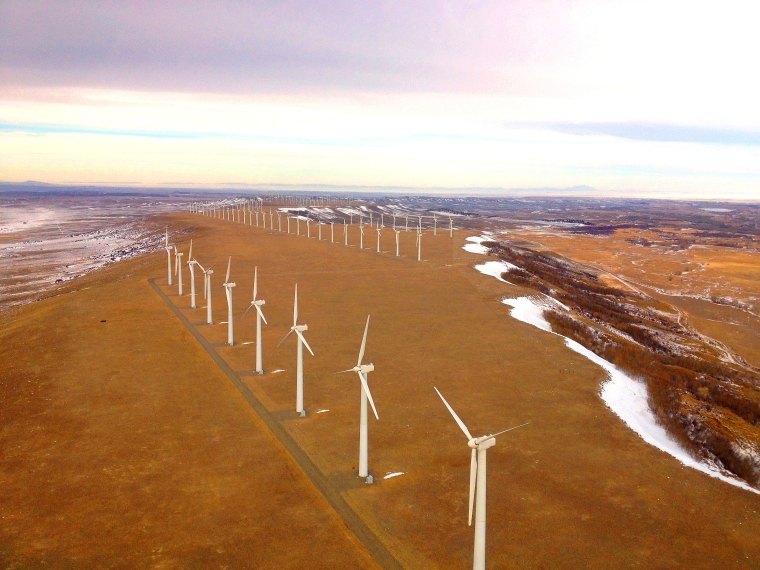 Wind farm located north of Arlington, Wyoming
Wind farm located north of Arlington, Wyoming
CCBJ: What role does hydrogen play on the energy transition markets?
Slessman: There is an enormous opportunity for hydrogen to help accelerate the world’s energy transition, but we’re still in the early stages of developing the technology and building the infrastructure. It’ll take time for a hydrogen economy to mature, starting with making current hydrogen production cleaner and preparing for future uses. Hydrogen can be generated from renewable sources through a process called electrolysis. When produced this way, hydrogen becomes a clean energy carrier, allowing us to store and transport renewable energy efficiently.
Hydrogen is expected to play a major role in reducing carbon emissions in sectors that are otherwise hard to decarbonize such as transportation, heating, and many industrial and manufacturing applications. By replacing traditional fossil fuels with hydrogen, we can significantly reduce carbon emissions.
Hydrogen also serves as a great way to store energy, especially when paired with intermittent sources like wind and solar power. During periods of excess renewable energy production, instead of wasting it, we can use it to generate hydrogen through electrolysis and store it for later use. This helps balance supply and demand on the grid. Hydrogen is already widely used in various industrial processes, such as refining petroleum, producing ammonia for fertilizers, and manufacturing chemicals. Transitioning to green hydrogen made from renewables can greatly reduce the carbon footprint of these industries, which supports their SDGs.
And finally, hydrogen fuel cells can power vehicles, offering an alternative to traditional engines and batteries. Vehicles powered by fuel cells emit only water vapor and heat, making them a zero-emission transportation solution.
CCBJ: What infrastructure development is needed for DOE’s Hydrogen Hubs?
Slessman: To effectively generate and use hydrogen as a clean energy source, we need infrastructure to transport hydrogen smoothly from where it’s made to where it’s used, like factories, power plants, or fuel stations. This infrastructure includes pipelines, liquefaction plants, trucks, storage units, compressors, and dispensing stations. Right now, there are technologies for delivering hydrogen commercially and several U.S. companies are already transporting hydrogen. But as the demand for hydrogen grows, we’ll need to expand this infrastructure regionally and develop new technologies, like special carriers for moving large amounts of hydrogen at once and faster fueling systems for vehicles powered by hydrogen fuel cells.
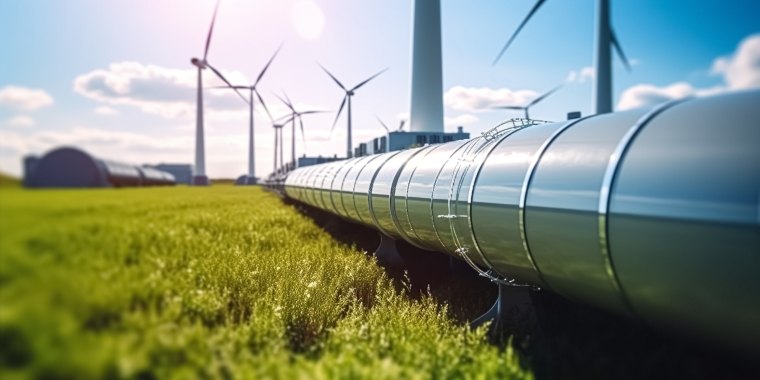 A hydrogen pipeline with wind turbines in the background
A hydrogen pipeline with wind turbines in the background
CCBJ: What hydrogen related services does SWCA provide?
Slessman: SWCA provides sustainability and management consulting to assess the risks and opportunities and develop the business case for proposed sustainability initiatives, including hydrogen developments. For example, an analysis by sustainability experts at SWCA revealed significant financial upside for a large green hydrogen project in the UK and helped move the project forward.
SWCA also supports the siting, permitting, and environmental planning for hydrogen projects and associated infrastructure. This includes preparing an Environmental Information Volume (EIV) as required for projects receiving DOE funding, which may include water resources management, wetland delineations, cultural resources management, land use planning and permitting, Tribal Relations, and public participation.
Our clients trust SWCA to conduct defensible and efficient environmental studies in support of green hydrogen projects. We have supported the development of concept documents and grant applications for future hydrogen projects.
Our expertise provides our hydrogen clients with valuable environmental and permitting process information early in project development and planning. We identify critical environmental issues, if any, and provide strategic planning support to identify and strategize project needs and develop schedules.
SWCA has contributed to or is working on over 30 hydrogen projects, and we have a proven track record of partnering with our hydrogen clients on grant funding applications, siting, permitting, and associated natural resource and cultural resource studies. Our firm specializes in assessments of environmental impacts, and we have translated our environmental alternative analysis expertise into one of the first Environmental Information Volumes (EIVs) required by the DOE for funding of newly selected projects.
SWCA follows strict confidentiality agreements regarding our hydrogen projects, so we can’t share specific details with outside parties. However, we can give you a general idea of how we support the hydrogen industry. For example, we’ve provided preliminary environmental support for a confidential hydrogen project in Texas. This involved preparing a Critical Issues Analysis and preliminary environmental permitting matrix, identifying key considerations that need special attention during project pre-planning, and facilitating interagency coordination across the engineering, environmental, and regulatory agencies involved.
We’ve also conducted a comprehensive review of the environmental permits necessary for a facility slated to produce hydrogen. Our analysis helped confirm the feasibility of expanding electrolyzer manufacturing for industrial purposes. We’ve also helped our clients apply for grant funding for innovative green hydrogen initiatives using wood fiber, by guiding the application process and providing expertise.
Furthermore, we’ve provided permitting expertise for an innovative solar thermal green hydrogen developer across three proof of concept sites. Our services included planning for land use permitting, conducting technical studies to meet state and federal environmental regulations, and analyzing cultural resources in accordance with Section 106 of the National Historic Preservation Act and Section 7 of the Endangered Species Act.
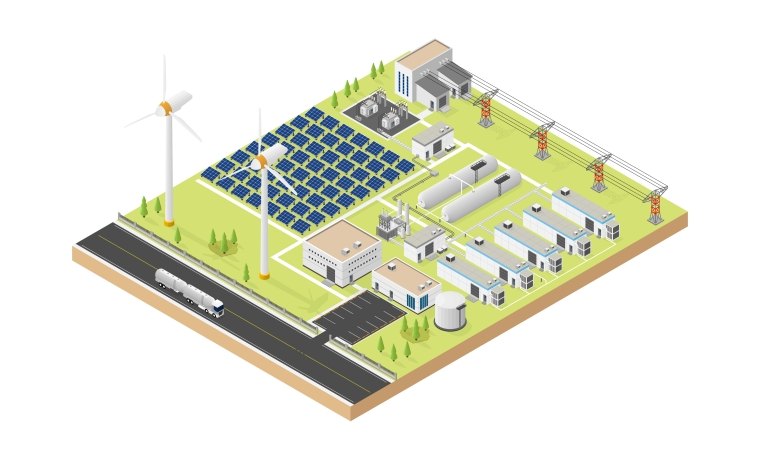 Hydrogen microgrid with wind turbine and solar cell in isometric graphic
Hydrogen microgrid with wind turbine and solar cell in isometric graphic
CCBJ: What workforce development and skill-building aspects related to the hydrogen services do you provide?
Slessman: The hydrogen industry and hub concepts fuse longstanding technology and infrastructure with new additions such as electrolyzers and capabilities for carbon capture, utilization and storage (CCUS). Leveraging our team’s extensive experience in evaluating and permitting similar projects over the years, we have cultivated expertise in assessing environmental impacts and securing permits for new power generation methods and feedstocks. This experience serves as a foundational knowledge base, adeptly applied to navigate the nuances of an emerging and rapidly expanding industry landscape.
CCBJ: Where and what are the biggest challenges related to planning and permitting of future assets in hydrogen?
Slessman: Challenges related to planning and permitting of the larger hydrogen economy touch on all aspects of generation, storage, distribution, transportation systems and regulatory hurdles. Some of the biggest challenges related to permitting and planning depend on the type of project. For example, the success of blue hydrogen projects, or those from traditional hydrogen generation like the steam methane reforming process coupled with carbon capture and storage, use, or permanent sequestration (CCUS), depend on the availability of carbon capture technologies and on permitting of the proposed method of use, storage or permanent sequestration. Establishing infrastructure for large-scale hydrogen storage, including options such as salt caverns, depleted gas reservoirs, or underground tanks, may encounter resistance from local communities or environmental organizations. For green hydrogen produced from renewable powered electrolysis, the permitting and planning processes differ and may be influenced by the siting of the renewable project, and the facility and the availability and suitability of water sources.
Regardless of the generation method, permitting large-scale hydrogen projects can be complex and have many interwoven components at the Federal, state, regional and local level. The expansion or creation of pipelines for transporting hydrogen over long distances faces challenges such as right-of-way acquisition, conflicts related to land use, and compliance with safety standards. Addressing concerns within the permitting processes regarding the safe and secure storage of hydrogen, due to its small molecular size and risks of leaks, is critical.
Infrastructure development and buildout of the transportation system creates additional challenges. Developing infrastructure for hydrogen fueling stations catering to fuel cell vehicles demands substantial investment and necessitates seamless coordination among government agencies, energy corporations, and automotive manufacturers. Navigating regulatory hurdles associated with the transportation and storage of hydrogen, encompassing safety protocols, transportation permits, and vehicle regulations, can potentially delay the deployment of hydrogen transport systems. Identifying appropriate sites for hydrogen refueling stations involves careful consideration of factors such as proximity to major highways, urban hubs, and regions experiencing heightened demand for fuel cell vehicles.
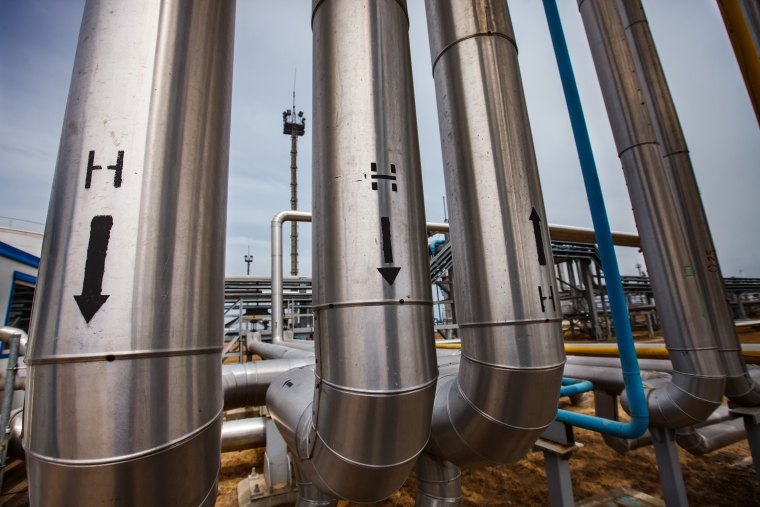 Typical hydrogen plant infrastructure
Typical hydrogen plant infrastructure
CCBJ: What are society’s main concerns with hydrogen?
Slessman: Society’s concerns regarding hydrogen encompass various aspects, including safety, environmental impacts, resource usage, and emissions.
Safety is a significant concern, particularly regarding the safe handling, storage, and transportation of hydrogen gas. For the hydrogen generation methods of hydrocarbon refining and CCUS, greenhouse gas and air pollutant emissions remain a concern. And while hydrogen fuel cells produce no emissions at the point of use, nitrous oxides (NOx) can be generated when hydrogen is combusted in internal combustion engines and require implementation of emissions controls.
Water usage is another concern, especially in arid regions. Large-scale hydrogen production methods, such as steam methane reforming or electrolysis, can require significant amounts of water, raising fears about competition for water resources. Additionally, large-scale hydrogen projects and infrastructure may impact ecosystems, habitats, and biodiversity.
The cost competitiveness of hydrogen relative to other energy sources, along with uncertainties about future market demand and investment risks, also create skepticism and may influence public and private sector support for hydrogen initiatives. Questions about the maturity of hydrogen technologies, reliability of infrastructure, and scalability of hydrogen production and distribution systems may impact confidence in the feasibility of transitioning to a hydrogen economy.
CCBJ: In which ways is technology facilitating the advancement of hydrogen?
Slessman: Technology is driving innovation and efficiency improvements across the entire hydrogen value chain, making hydrogen projects more economically viable, scalable, and sustainable. These advancements are paving the way for hydrogen’s use as a clean and versatile energy source in our shift towards a low-carbon economy.
Advances in electrolysis technology are increasing efficiency, reducing costs, and enhancing scalability. For example, the development of electrolyzers using proton exchange membrane and alkaline technologies is a game changer.
Technology is also improving methods for storing and transporting hydrogen efficiently and safely. New designs for compressed and liquid hydrogen storage have advanced for use in transportation, industrial applications, and storage systems as well as in the transportation of hydrogen with pipelines, tankers, and transport containers. There are multiple companies developing distributed electrolysis systems to be used on-site instead of in large centralized production facilities.
Besides electrolysis, technology is enabling the production of hydrogen from alternative sources like biomass and waste. Traditional methods, such as steam methane reforming, are now focusing on capturing and storing carbon emissions. These new production methods offer opportunities for decarbonizing hard-to-electrify sectors, but widespread adoption will require infrastructure upgrades to support hydrogen as a clean energy source.
